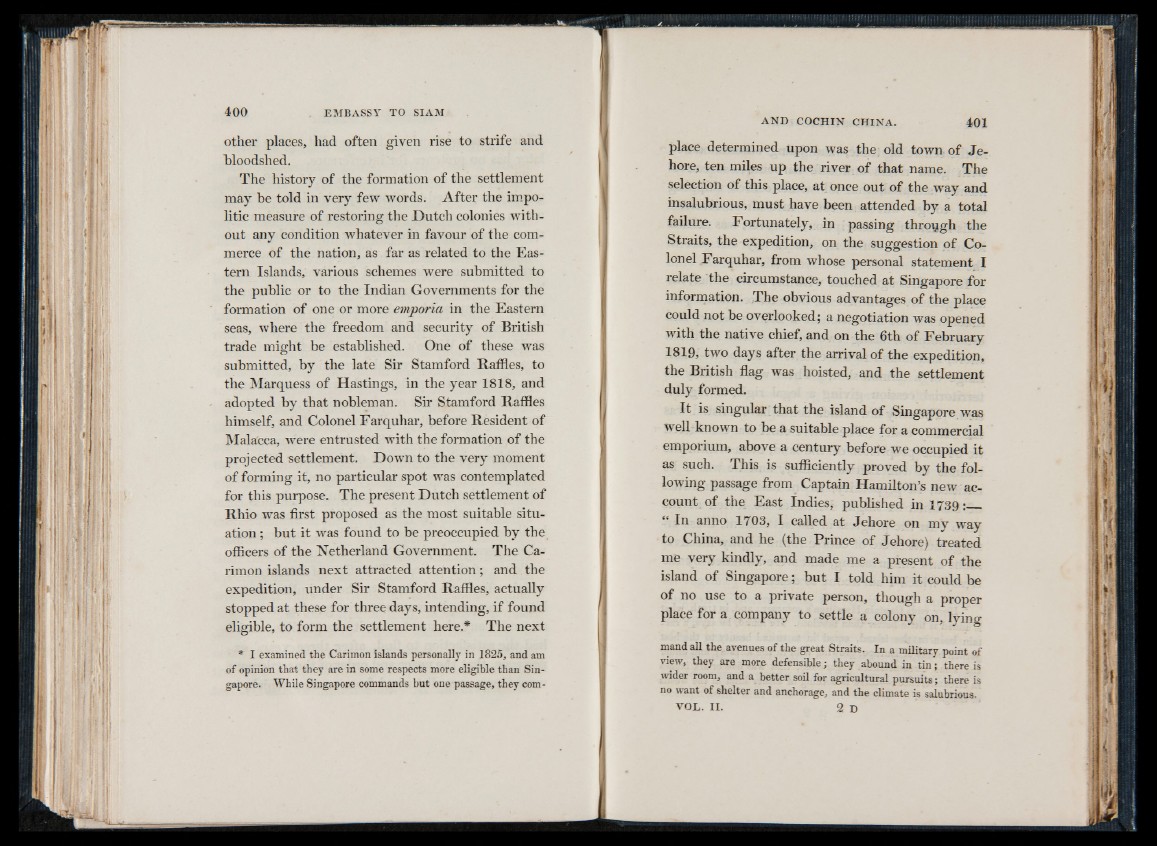
other places, had often given rise to strife and
bloodshed.
The history of the formation of the settlement
may be told in very few words. After the impolitic
measure of restoring the Dutch colonies without
any condition whatever in favour of the commerce
of the nation, as far as related to the Eastern
Islands, various schemes were submitted to
the public or to the Indian Governments for the
formation of one or more emporici in the Eastern
seas, where the freedom and security of British
trade might be established. One of these was
submitted, by the late Sir Stamford Raffles, to
the Marquess of Hastings, in the year 1818, and
adopted by that nobleman. Sir Stamford Raffles
himself, and Colonel Farquhar, before Resident of
Malacca, were entrusted with the formation of the
projected settlement. Down to the very moment
of forming it, no particular spot was contemplated
for this purpose. The present Dutch settlement of
Rhio was first proposed as the most suitable situation
; but it was found to be preoccupied by the
officers of the Netherland Government. The Ca-
rimon islands next attracted attention; and the
expedition, under Sir Stamford Raffles, actually
stopped at these for three days, intending, if found
eligible, to form the settlement here.* The next
* I examined the Carimon islands personally in 1825, and am
of opinion that they are in some respects more eligible than Singapore.
While Singapore commands but one passage, they complace
determined upon was the old town of Je-
hore, ten miles up the river of that name. The
selection of this place, at once out of the way and
insalubrious, must have been attended by a total
failure. Fortunately, in passing through the
Straits, the expedition, on the suggestion of Colonel
Farquhar, from whose personal statement I
relate the circumstance, touched at Singapore for
information. The obvious advantages of the place
could not be overlooked; a negotiation was opened
with the native chief, and on the 6th of February
1819, two days after the arrival of the expedition,
the British flag was hoisted, and the settlement
duly formed.
It is singular that the island of Singapore was
well known to be a suitable place for a commercial
emporium, above a century before we occupied it
as such. This is sufficiently proved by the following
passage from Captain Hamilton’s new account
of the East Indies, published in 1739:__
In anno 1703, I called at Jehore on my way
to China, and he (the Prince of Jehore) treated
me very kindly, and made me a present of the
island of Singapore; but I told him it could be
of no use to a private person, though a proper
place for a company to settle a colony on, lying
mand all the avenues of the great Straits. In a military point of
view, they are more defensible; they abound in tin; there is
wider room, and a better soil for agricultural pursuits; there is
no want of shelter and anchorage, and the climate is salubrious.
VOL. I I . 2 D